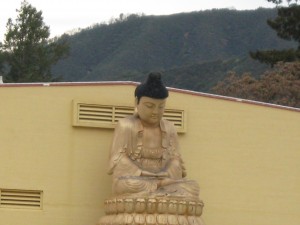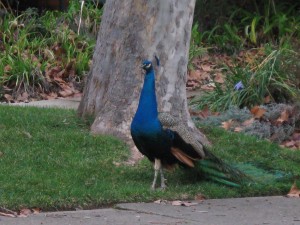 The town of Talmage in Mendocino County has a population of less than 1200. The mean average income is $35,000/year. The town is mostly white, but 16% Asian, which seems surprising in coastal northern California—surprising until you realize that most of Talmage is the City of Ten Thousand Buddhas.
The town of Talmage in Mendocino County has a population of less than 1200. The mean average income is $35,000/year. The town is mostly white, but 16% Asian, which seems surprising in coastal northern California—surprising until you realize that most of Talmage is the City of Ten Thousand Buddhas.
Who knew?
The Dharma Realm Buddhist Association opened its northern California monastery and school in Talmage in 1976. The property had been used for a mental institution, but it was closed in the late 1960s by then-governor Ronald Reagan who thought institutions cost too much taxpayer money, and those people would be better served, as he called it, “in the community,” or, as the rest of us called it, on the streets. This left institutional buildings and grounds that the DRBA was probably able to pick up cheap.

My friend Kathleen and I drove through the Mountain Gate onto the grounds, following the signs to the Administration building. The monastery welcomes visitors but everyone needs to check in, and there are rules that must be followed. Beyond the green-and-orange multi-tiered gate that really does look like a mountain, the green grass and black, leafless oak trees contrasted with the pale orange buildings. A male peacock strolled across the pavement in front of us, dragging his shimmering multi-eyed tail like a train. Another followed, and another, and then a clutch of short-tailed peahens. There are probably about forty peacocks on the property. Over the roofs of some of the lower buildings I could see the head of an enormous Buddha statue.
The inside of the Administration Building is institutional, except for a large marble Quan Yin by the door. A slight, soft-spoken, pleasant man at the counter welcomed us and gave us a map. He explained that the Hall of Buddhas, the vegetarian restaurant, organic garden and Japanese-styled Koi pond were open to the public, and marked off the areas that were not open to the public because the monastery and the schools are gender restricted. The Hall of Buddhas, he said, maybe really did have 10,000. He didn’t seem overly concerned about whether that figure was exact. It’s just the name of the place. He told us a story about the founder, Hsuan Hua, coming from China, to be told there was no water on the property. This monk had a gift for finding water, so he hired a well-digging company and walked around the property, with them trailing behind him. Finally he pointed to a spot and said, “Dig.” The well drillers dug for a while, down deep, and didn’t find water. When they told the monk this, he merely pointed and said again, “Dig.” They did, very deep indeed, and found water—lots of water.
The founder, Hsuan Hua, apparently carved many of the Buddha statues that are in the Hall of Buddha, where we were on our way next.

It was about four pm on a cool, cloudy January day, and quiet except for the eerie, imperative calls of the peacocks. Now and then we would see a person, bundled in dark colors, wearing a head-covering regardless of gender, walking across the grounds. We started toward the hall but were immediately distracted by the beautiful, fearless peacocks and had to take several pictures of them. I’m sure there’s some Buddhist message here about being seduced by the temporal beauty of the world and all. Anyway, after a few minutes we made our way to the old gymnasium, which holds the Buddhas and scores of orange kneeling pillows for their services. On each side of the central door is a mosaic of the Buddhist Lord Protector, one in his angelic aspect and one in his warrior aspect. The roof of the porte cochere holds a large statue of the Buddha, and on the pavement before the entrance sits a large cylinder hung with bells. I forgot to ask what it was for. It looks like wrought iron but might have black painted ceramic, and was hollow inside, with a step-ladder rested against it. I don’t know if they ring the bells or burn incense or something in its interior.

Inside is a large gold-leaf statue of their founder, flanked by the Lord Protector in two aspects; fierce warrior-red and tranquil, angelic gold. We stepped inside, into a huge room. The walls are lined with rectangular shelved niches and each one holds a Buddha. Niches have been built into the two beams that run the length of the ceiling, and they hold smaller statues. At the back of this space stand seven bronze statues in various aspects of the Buddha including four Quan Yin figures. At the front, spot-lit, a large gold-colored thousand-armed Buddha commands the eye. It is surrounded with life-size Buddha figures and then smaller figures on the railing. On the floor level rest a line a musical instruments, mostly percussive, and two massive red-painted drums hang from the ceiling, as well as a couple of large bells. Kathleen said, of one, whose rope bell pull was within easy reach of our fingers, “I really want to ring that bell.” I quickly pretended that I didn’t know her. (She didn’t ring the bell.)
People can buy a statuette and bless it in the name or on behalf of a person, and that person will receive some of the benefits of the daily chanting of the mantras and sutras for one year. These plastic Buddhas are stacked in conical stands and there are three of them in the hall. This confuses me, since it seems like you are purchasing blessings, just like in those good old Christian churches. Maybe I don’t understand Buddhism very well.
We were both struck, actually, with how Catholic it felt. Since what I loved most about Catholicism, what almost seduces me back to the church, is the pageantry, this was almost like a homecoming; incense, candles, colored lights, and glorious statues. The other thing I love about Catholicism is its miracles, and a water-spotting monk probably qualifies as a miracle.
The site hosts a school (pre-school through middle school), boys and girls, but in separate facilities. Our host said that there were about 30 residential (boarding school) boys and perhaps about 50 girls. There were also some local day students. He says they do well academically, since they are not “distracted by the other gender” and because internet use is strictly restricted to schoolwork use. There are also adult monks and nuns. They offer retreats and volunteer days, such as Farm Day, and other events. The ten-acre vineyard, the garden and the walnut grove all help provide for the monastery, as well as school tuition and those plastic Buddha figures.
We asked about the peacocks and the garden. He said, “I don’t know about peacocks in other places, but ours are vegetarian.” And yes, they do eat the garden. He said, “They have a right to eat too,” which instantly illustrated to me one way in which Buddhism is different from western thought. He said that the Chinese people who come to this Buddhist sect are seeking compassion while Westerners are looking for a different perspective.
The City did give a different perspective, and it was a surprise. It is a beautiful, peaceful place to stop, and probably quieter on a weekend. Cell phones are discouraged, and they request that people dress modestly.

Thanks a lotI really enjoyed reading this. It makes me want to create my own weblog! Just what subject though? I am a dentist by trade but can’t imagine many people wishing to read about dentistry? Maybe I am wrong! Restaurant Devon
Pingback: city of ten thousand buddhas
Hello. Just sharing the link for the City of 10,000 Buddhas website with you:
http://www.cttbusa.org/
Jassie, thank you!
We are a group of volunteers and starting a new project in our community. Your post provided us with valuable information to help us get started|.You have done an impressive job!
Hi Marion. I live a few blocks from the City of 10,000 Buddhas and thought your description was very good. The peacocks are actually the descendants of some peacocks who were “liberated”, that is, bought from a farm that raises them for food, a mantra was said over them, then they were released and have lived there ever since, raising their young and getting food from visitors and the residents. There used to be an albino one!They are a little noisy, but because the place is so large, it isn’t a big problem for neighbors.
Sarah, thanks for that info! Very interesting. They were beautiful.